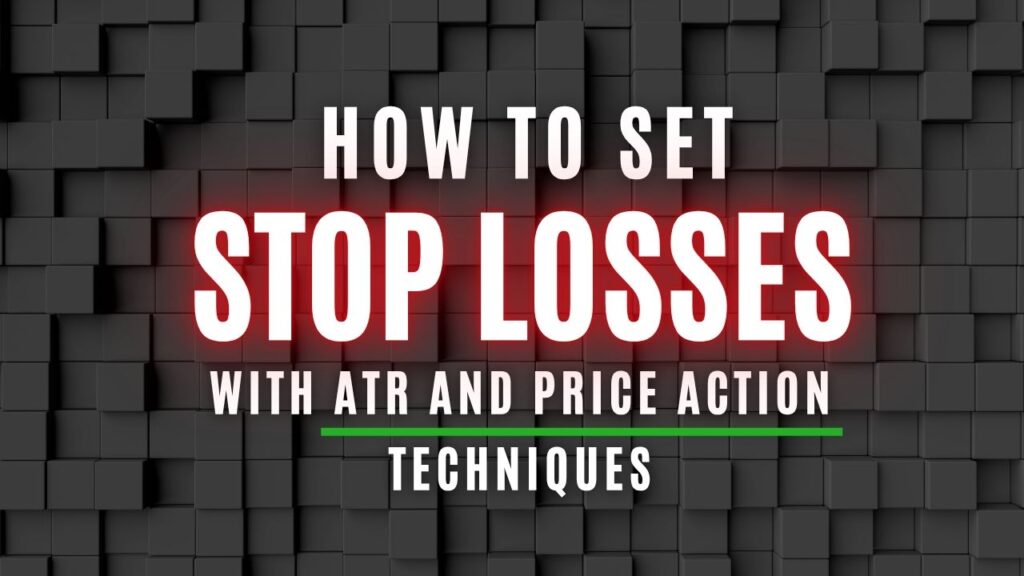
🛡️ Introduction: The Importance of Stop Losses
When you’re trading, risk management is really key to locking down a solid strategy. Learning how to Set Stop Losses with ATR and Price Action is a huge deal to keep risk under control. A stop loss is simply an order to close a trade when the price reaches a certain level, so you don’t lose more than you’re comfortable losing. By using ATR and price action techniques, you can place your stops more strategically, improving your odds of success.
Setting stop losses can be a little tricky at times. If you set them too tight, you can get stopped out of trades way too early. And if they’re too loose, you can lose a fortune if the market turns against you. Two popular methods of setting stop losses correctly are the Average True Range (ATR) and price action methods. Both of these methods allow traders to determine intelligent and precise stop losses based on current market action.
In today’s article, we will discuss using price action and ATR to set stop-losses that protect capital while still leaving some breathing room in each trade.
📊 What is ATR (Average True Range)?
The Average True Range (ATR) is a neat volatility indicator by J. Welles Wilder. It looks at the average range between the highs and lows over a given time, say 14 time periods, and calculates for you how crazy the market’s been. Just so you know, though, the ATR won’t give you the direction the price is going; it’ll only indicate how much it’s moving around.
ATR is extremely useful in terms of determining a stop loss because it varies with how wild the market is. As the market goes wild, ATR increases, and when the market calms down, ATR decreases.
✅ Main Points About ATR:
- Volatility Measure: ATR doesn’t indicate price direction; it simply shows how much the price moves in a given timeframe.
- The ATR does not exactly indicate in which direction it’s gonna go up or down; it simply indicates how much movement to expect.
- It is very versatile and can work on any market—stocks, futures, and forex—and any timeframe, making it suitable for all types of traders.
📈 What is Price Action?
Price action is all about looking at how prices move on a chart. It’s deciphering those candlestick patterns, chart patterns, and levels of support and resistance to get a sense of where the market may go. Price action traders only look at the price chart itself, no indicators, and read the vibe of the market to make their decisions.
Price action is really useful in determining stop losses because it illustrates to you the most important price levels at which the market may change things around or break out. By observing price patterns like pin bars, engulfing patterns, or areas of support and resistance, traders are able to identify good places to locate their stop losses so they don’t get stopped out of a trade too early or too late.
🛠️ How to Implement Stop Losses with ATR
So when using the ATR to determine how far to set stops, you’re essentially setting it at some multiple of the ATR itself. That way, it’s close enough to the entry price to account for normal price fluctuation, but far enough away so as to avoid having the losses spiral.
📚 A Cool Guide to Implementing ATR for Stop Losses:
- Calculate the ATR:
First things first, calculate the ATR for the time period you are trading. I.e., if using a 15-minute chart, simply calculate the ATR on the last 14 bars (or simply utilize the ATR indicator on whatever charting software you are using). - Choose a multiple of ATR:
Now that you have the ATR value, select a multiple that suits your risk tolerance and how much you prefer to trade. A general range to target is between 1x and 2x ATR. For instance:- If the ATR is 20 pips, you can completely place a stop-loss at 20 pips (1x ATR).
- If a higher volatility is desired, the stop loss may be set at 40 pips (2x ATR).
- Determine the Stop Loss Placement:
Therefore, when you’re going long (purchasing), you ought to completely place the stop loss beneath where you entered by some multiple of the ATR.
If you have an existing long position (when selling), simply set your stop-loss a couple of times the ATR away from entry. - Adjust for Market Conditions:
ATR takes a licking when the market goes completely haywire. In really choppy markets, the ATR increases, and your stop loss simply increases accordingly to accommodate those larger price movements. As the market settles down, however, the ATR declines and reduces the stop distance.
📌 Example:
Here it goes: I’m trading the EUR/USD on the one-hour chart, and the ATRs are reading at 30 pips. I’m entering long at 1.200, and I want to set my stop loss to 1.1970 (that’s a multiple of 30 pips using a 1x ATR) if I’m using a 1x multiple. Or if I’d like to have some breathing space, I could use a 2x multiple and plant my stop loss at 1.1940.
🧠 How to Use Price Action to Set Stop Losses
Price action is much more effective when it comes to determining the placement of stop losses. Really, it’s all about putting on stop losses at good price levels supported by price patterns and support and resistance.
🧾 Applying Price Action to Avoid Losing Money: The Beginner’s Guide
- Spot Support and Resistance:
- If you’re going long, place your stop loss just below a recent support level or swing low.
- If short selling, simply place your stop a little above a prior resistance level or swing high.
- Explore Candlestick Patterns:
- So a pin bar sort of indicates the price level is not being accepted, okay? You may wish to set your stop loss just beyond the wick of the pin bar.
- If you see a bullish engulfing pattern at support levels, simply place a stop loss a little below the low of the engulfing candle.
- See the newest highs or lows:
- One smart thing to do is to set a stop-loss slightly below the recent swing low when long, or slightly above the recent swing high when short.
- Watch for Breakouts:
- So if you are entering a breakout trade, be certain to have a stop-loss below the breakout level if buying or above it if selling.
📌 Example:
If you’re holding S&P 500 futures and considering a long entry near 4,050 and notice some support available in the area around 4,040, you may want to place your stop loss a little bit below support, say around 4,038, to have some wiggle room in the trade.
🔗 Using ATR and Price Action to Determine Stop Losses
Combining ATR and price action is a good formula to determine stop losses. ATR provides a real-time sense of how wild the market is behaving, and viewing price action allows you to notice those important price levels at which the market may bounce back or continue to move in your direction.
🧪 How to Mix Both Ways:
- First, determine the price action levels:
- Look for key price levels like support, resistance, candlestick patterns, or recent highs/lows.
- Simply employ ATR to adjust the distance:
- After you’ve established those price action levels, have a look at the ATR to ensure the stop loss is not too tight or too loose.
- Final Placement:
- Place the stop-loss at the appropriate price action level but adjust the distance with the ATR to ensure it is in line with the prevailing mood of the market.
✅ Wrapping Up: Best Tips to Set Stop Losses
Determining the appropriate stop loss is incredibly vital in terms of managing risk and keeping cash intact. Regardless of whether you’re using ATR or price action, or a combination of both, you’re going to position the stop losses at a place that leaves your trades a little wiggle room but also doesn’t get kicked out prematurely.
- ATR is great for establishing stop losses that adapt to how wild the market is.
- Price action tells you a good area to expect a bounce in the price, and it provides a better indication of stop losses.
- Using both methods keeps pace with the fluctuations in the market as well as observes how prices fluctuate.
If you master these techniques, it’ll definitely level up your risk management and make you trade much smarter and more efficiently. 🚀



But wanna state that this is handy, Thanks for taking your time to write this.
Very excellent visual appeal on this website , I’d rate it 10 10.